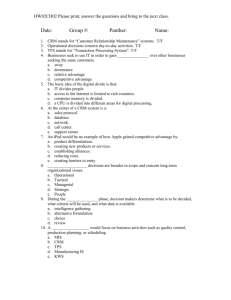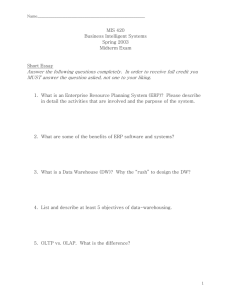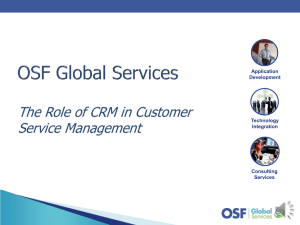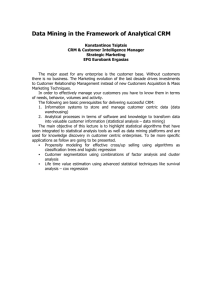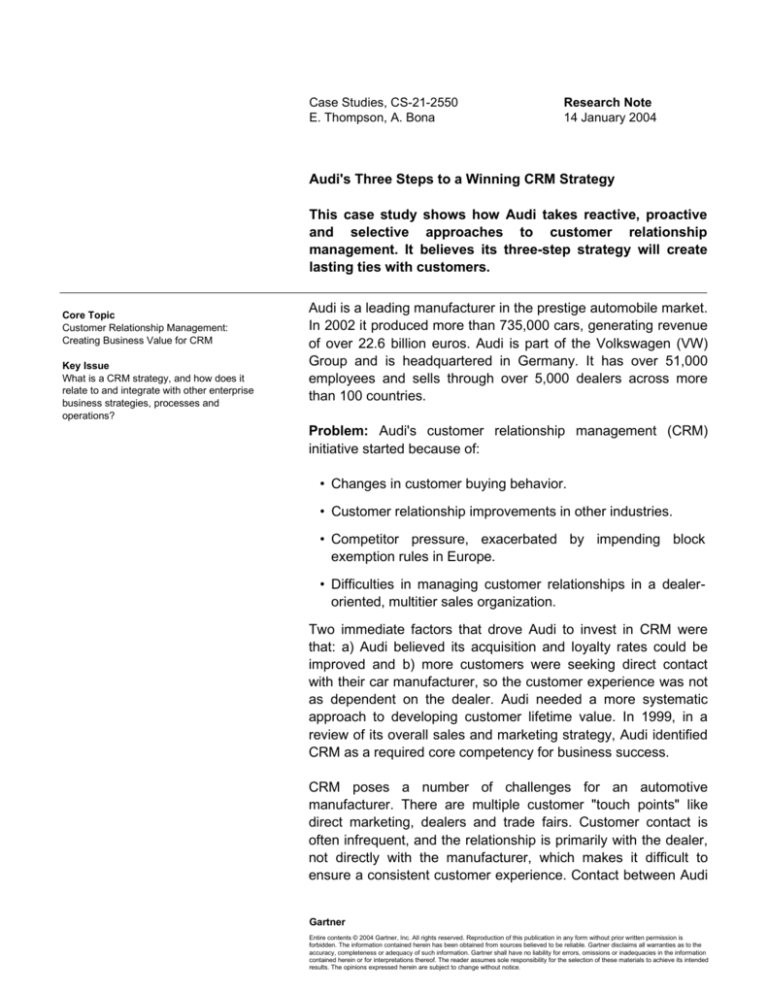
Case Studies, CS-21-2550
E. Thompson, A. Bona
Research Note
14 January 2004
Audi's Three Steps to a Winning CRM Strategy
This case study shows how Audi takes reactive, proactive
and selective approaches to customer relationship
management. It believes its three-step strategy will create
lasting ties with customers.
Core Topic
Customer Relationship Management:
Creating Business Value for CRM
Key Issue
What is a CRM strategy, and how does it
relate to and integrate with other enterprise
business strategies, processes and
operations?
Audi is a leading manufacturer in the prestige automobile market.
In 2002 it produced more than 735,000 cars, generating revenue
of over 22.6 billion euros. Audi is part of the Volkswagen (VW)
Group and is headquartered in Germany. It has over 51,000
employees and sells through over 5,000 dealers across more
than 100 countries.
Problem: Audi's customer relationship management (CRM)
initiative started because of:
• Changes in customer buying behavior.
• Customer relationship improvements in other industries.
• Competitor pressure, exacerbated by impending block
exemption rules in Europe.
• Difficulties in managing customer relationships in a dealeroriented, multitier sales organization.
Two immediate factors that drove Audi to invest in CRM were
that: a) Audi believed its acquisition and loyalty rates could be
improved and b) more customers were seeking direct contact
with their car manufacturer, so the customer experience was not
as dependent on the dealer. Audi needed a more systematic
approach to developing customer lifetime value. In 1999, in a
review of its overall sales and marketing strategy, Audi identified
CRM as a required core competency for business success.
CRM poses a number of challenges for an automotive
manufacturer. There are multiple customer "touch points" like
direct marketing, dealers and trade fairs. Customer contact is
often infrequent, and the relationship is primarily with the dealer,
not directly with the manufacturer, which makes it difficult to
ensure a consistent customer experience. Contact between Audi
Gartner
Entire contents © 2004 Gartner, Inc. All rights reserved. Reproduction of this publication in any form without prior written permission is
forbidden. The information contained herein has been obtained from sources believed to be reliable. Gartner disclaims all warranties as to the
accuracy, completeness or adequacy of such information. Gartner shall have no liability for errors, omissions or inadequacies in the information
contained herein or for interpretations thereof. The reader assumes sole responsibility for the selection of these materials to achieve its intended
results. The opinions expressed herein are subject to change without notice.
and its customers is often a result of negative experiences like
repairs and maintenance. There is often difficulty in convincing
dealers that it would be worth their while to give valuable
customer data back to the manufacturer.
Objective: Audi sees CRM as a strategic marketing discipline for
systematically acquiring and retaining customers. It is taking a
long-term approach to CRM in that, at any one moment, it is
involved with between 30 and 50 different projects around the
world. This case study looks at the results of some of the first 50
projects.
Audi's approach can be summarized using Gartner's Eight
Building Blocks of CRM Framework (see "The Eight Building
Blocks of CRM").
CRM Vision
Audi's brand values are in being sporty, progressive and
sophisticated, and in having an association with leading-edge
automotive technology. Behind Audi's vision for CRM was the
idea that innovation, intensive dialogue and unique customer
orientation would convince customers to establish long-term
partnerships with it. Audi has analyzed key life stages to look for
customer needs such as improved mobility, convenience and
more space. For example, parents with a new child may want
more passenger space, and a customer who has taken up golf
may want more trunk space.
Customers need to be heard and made aware of what's available
in the Audi product range; otherwise they will look elsewhere. In
its vision of CRM, Audi decided to differentiate between the
entire customer experience and a subset of this, known as the
"contact experience." Audi was aware that the customer
experience is affected by many factors, including car design,
availability of spare parts, the test drive and the attitude of the
dealer. Audi chose to focus on the contact experience, where
some immediate effect could be felt.
Approach:
CRM Strategy
The goals of Audi's CRM strategy are to improve directly the
customer's acquisition levels and loyalty. The CRM strategy is
interrelated with the brand, sales and IT strategies for Audi and
the VW group. Audi started by analyzing core competencies and
setting performance targets. Its CRM strategy has three broad
steps.
Copyright 2004
CS-21-2550
14 January 2004
2
• Reactive CRM: "Do ordinary things extraordinarily well" by
providing excellent inbound customer service processes for
customer contacts. These processes cover everything from
inquiries about new vehicles to information on financing
options.
• Proactive CRM: "Create as many customer relationships as
possible," and increase customer loyalty and market share
through improvements to outbound processes such as
campaign management.
• Selective CRM: "Select and treat customers by segment" to
focus on customer profitability by creating loyalty programs
and integrating with dealers more tightly.
These three steps are happening at different speeds in different
markets and are iterative. Audi recognizes that the steps overlap,
but believes the order is important, as there is no point investing
in sophisticated propensity analysis if the complaints
management procedure is inadequate.
CRM Processes
Audi looked at what it does for its customers (value), how it does
it (processes), and then what tools could improve them. The
processes for inquiries ("Can I have a brochure for the new A4?")
and complaints management ("My tire has burst, my spare is flat
and I am on holiday abroad") were identified as key influences on
the customer experience.
These processes have been optimized by using a common
knowledge base. Customer histories are now available to agents.
A single agent is responsible for this, regardless of the inbound
channel, handles each inbound contact electronically. Pre-sales,
aftersales and other Audi business units now have an integrated
set of processes that reduces the number of interfaces between
internal business units, centralizes coordination and control,
shortens lead times and lowers service costs.
Organizational Collaboration
Extensive change management activities were carried out, and
are still in place, to intensify the focus on customer needs. The
entire organization, not just the customer care center, strives to
maintain this focus. The marketing department is responsible for
"owning" CRM and developing the CRM strategy, but CRM is
cross-functional and so local customer care and workshop
departments are responsible for operational CRM, as they are
intimately connected to the needs of the customer locally.
Copyright 2004
CS-21-2550
14 January 2004
3
To coordinate CRM better, the pre-sales and after-sales
customer service organizations were merged. More recently, in
2003, the Internet and CRM activities were consolidated, so that
CRM is responsible for the Internet as a communications
channel. Customer service agents now take ownership and
responsibility for ensuring customer satisfaction. Other
departments, such as the export and legal departments, have
been given access to customer data and can add comments
directly into the system. A new group was established to handle
requests from dealers, registering all contacts related to
customer requests.
CRM Technology
At the heart of Audi's CRM technology is KuBa, its customer
database. This gives users a complete picture of customer
information across the whole of Audi. KuBa displays technical
details, interior equipment data for each vehicle and dealer
master data. KuBa was built on mySAP CRM — the platform for
CRM throughout the VW Group. The nonSAP order management
system was integrated into KuBa, so that when an order is
created for a new customer, a new vehicle record, and new
customer and dealer relationship details are automatically
created. The Audi knowledge base, where correspondence
templates are stored, is fully integrated into the KuBa system.
The vehicle data warehouse has not yet been fully integrated,
although some data is extracted from it and fuller integration is
planned. An e-service tool called "Ask" has been integrated into
mySAP CRM.
Audi started implementation in September 2001 and went live in
Germany in April 2002. This was followed by Italy in February
2003 and Brazil in March 2003. There are about 300 Audi users
on the system and roughly 500,000 of its 3 million customers in
these markets have used the system. A major challenge for the
future will be a more complete integration with dealer
management systems.
Transformation of Data Into Applied Insight
Integration of customer data was a big challenge for Audi. There
were various customer databases in Germany, some of which
were more than 20 years old. Like all large automotive
manufacturers, Audi has a "heterogeneous landscape" of
numerous dealer management systems. Its long-term vision is to
standardize these systems, but this can only be done over the
next five to 10 years as the supplier contracts expire. Meanwhile,
Audi is taking a phased approach to data integration. KuBa
contains master data and interaction data and is used for day-today operations. It feeds the SAP Business Information
Copyright 2004
CS-21-2550
14 January 2004
4
Warehouse (SAP BW), which is used for service analytics,
campaign management and to help improve product life-cycle
analysis. SAP BW insights can then be used to optimize
customer-facing processes and to gather market intelligence that
can then be fed back to product development.
Customer Experience
Audi looked at key customer interactions from the customer
perspective. It devised what it called "customer walks" to
understand the detail of the customer experience, and discover
what was inadequate. For example, when visiting a showroom, a
customer might try to park his or her car, only to find all the
spaces blocked by dealers' cars.
The type of customer experience that Audi is aiming for can be
described in the reactions from customers that Audi wants to
hear.
• "Audi takes me seriously, they have never disappointed me."
• "Audi knows me and my needs."
• "Audi doesn't only want to sell cars to me."
A single point of contact in the call center and multichannel
access have helped Audi provide customers with a positive
experience. Analytics are used to monitor service performance
and gain market insights. These enable Audi to continuously
improve its customers' experience, and to tailor products and
services to customer segments or individuals.
The customer experience is determined mostly by the dealers
and by the car itself. So it is critical to improve product quality
and to work more tightly with dealers. Audi is training its dealers
more intensively in customer service. It is putting required service
standards in its dealer contracts and providing dealers with better
tools and processes for effectively managing customer
relationships.
Customer-Centered Metrics
A balanced scorecard approach is central to the CRM initiative.
SAP BW provides valuable qualitative and quantitative insights
into Audi's market and the quality of customer interaction. This
means Audi can quickly identify market opportunities by
analyzing the response to a marketing campaign from customers
and prospects. A recent personalized marketing campaign in
Italy, aimed at A8 owners, demonstrated response rates of 11
percent. This was four times the average rate from direct
marketing. Within the existing Audi customer segment, the
response rate was nearly 15 times the average. An analysis of
Copyright 2004
CS-21-2550
14 January 2004
5
requests and complaints by vehicle type is fed back to product
management and development.
Audi focuses on metrics for satisfaction and retention as part of
the balanced scorecard. It uses the New Car Buyer Study to
measure how many customers replace their Audi with another.
The introduction of a loyalty program has increased the retention
rate of Audi owners. The results are unclear by how much, as
typical car replacement happens every four to six years in
Germany, so it will take longer for meaningful statistics to be
available. The goal is to increase loyalty by 3 percent.
Audi also uses indexes such as the Customer Satisfaction Index
and American Customer Satisfaction Index, to compare itself with
competitors in terms of overall satisfaction and of satisfaction
with the dealer, workshop and vehicle. Audi is using these
measures to identify the quality of its contact experience in those
processes it can influence, such as the test drive. It is working to
fix the basics first by integrating internal information on these
processes with information from the dealers, importers and
distributors.
Results: Audi has built a highly effective and efficient
multichannel customer care center for the German, Italian and
Brazilian markets, which will roll out to other countries. Audi now
has effective, individualized marketing campaigns. Customer
process costs, in areas from brochure request to delivery, have
improved dramatically, and lead-processing times have been
reduced by more than 80 percent. According to its customers,
Audi has also improved the quality of customer communication
by personalizing it.
Critical Success Factors/Lessons Learned:
• A detailed definition of requirements is key.
• It is critical to have a long-term perspective on strategy, to
implement some of that strategy at an operational level, and
to re-evaluate it in light of the success, or otherwise, of the
operational CRM.
• The internal merger of the customer care units helped
coordination.
• Knowledge and mapping of business logic and processes
before implementing them in the application technology.
• Implementation of CRM must be carried out one project at a
time. Audi has completed over 50 projects, each lasting no
more than six to nine months, and has as many as 50 more
in progress at any one time. It is measuring the success of
each project.
Copyright 2004
CS-21-2550
14 January 2004
6
• Key users should be involved at an early stage.
Bottom Line: Audi's CRM strategy stands out strongly. Its threestep approach of reactive, proactive and selective CRM shows
that basic levels of customer service must be met first before upselling or cross-selling, and that a step-wise approach to CRM is
more successful.
Copyright 2004
CS-21-2550
14 January 2004
7


